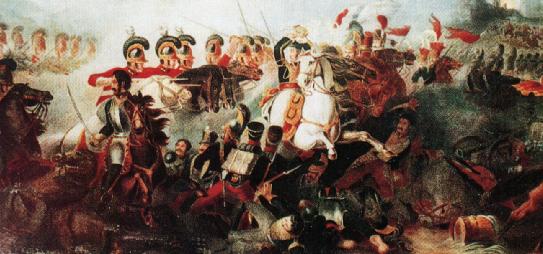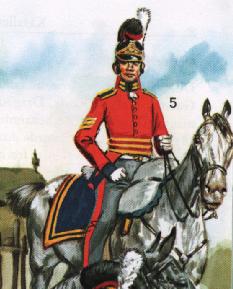
British Household Cavalry

The Household cavalry was composed of 3 regiments - the 1st and 2nd Life Guards, and the Royal Horse Guards ("The Blues"). These regiments did not see action in the Peninsular War until the end of 1812. At that time, they wore a helmet with a flowing horsehair mane. The horsehair mane was changed in 1814 to a woolen crest which was coloured dark blue over red (see illustration above). The new helmet was worn at Waterloo.
The uniform of the 1st and 2nd Life Guards was a scarlet jacket with blue facings on the cuffs which were usually obscured by their white gauntlets.
The Royal Horse Guards wore a blue jacket - hence their nickname, "The Blues". They had red facings on collar and cuffs.
On campaign, the household cavalry wore grey trousers (overalls) with a red stripe.
At Waterloo, the 3 regiments of household cavalry fielded 2 squadrons each - totalling 696 men - i.e an average of 116 men per squadron.


L - Life Guard NCO; R - Blues Officer (Note: The troopers did not have the gold and red vertical stripes down the front of the jacket - troopers' jacket had a simple front, similar to that shown in the illustration of the Life Guards NCO - except that their jacket was blue.)
Illustrations taken from Liliane and Fred Funcken, Historische Uniformen - reproduced with kind permission of the authors.
Sources:
Liliane and Funcken - Historische Uniformen
Ugo Pericoli - 1815 - The Armies at Waterloo
Philip Haythornthwaite - Uniforms of Waterloo
Bryan Fosten - Wellington's Heavy Cavalry - Osprey Men-at-Arms
[an error occurred while processing this directive]